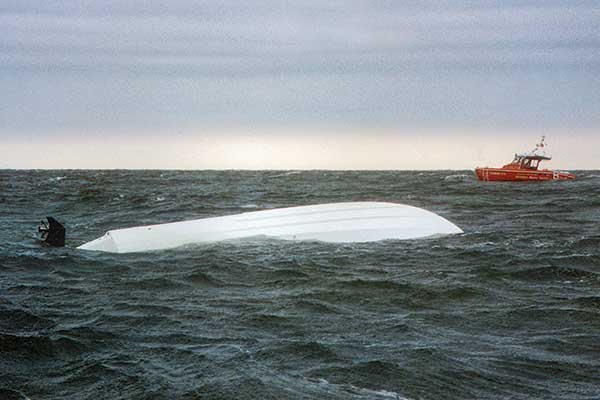
Why
Nearly all boat capsizing can be assigned one of three causes.
The most common is too much or poorly distributed weight.
Small boats are much more susceptible to an extra person or two or a couple of heavy coolers aboard than larger boats. Older boats especially may have gained weight over the years as more gear is stored aboard.
On boats with cockpit drains, an extra beefy friend or a second cooler might be all it takes to make the water come back in through the drains, filling the boat. While most of these under-20 foot boats are required to have flotation, they also must have a capacity plate that states how much weight and how many people can safely be aboard. Pay attention to this number. Exceeding the capacity limits, even in calm water, is asking for trouble; and in many states, operators can be ticketed for it. All it takes is a stiff wind, a large wake, or an unbalanced load to flip over.
The bottom line is that loading too much cargo or too many passengers in one part of the boat can affect its stability, even if the total load is within the boat’s maximum capacity. Weight needs to be evenly distributed, especially in smaller boats. One other thing worth mentioning is that capsizes can also be caused by modifications that affect the stability of the boat. Even a small tuna tower can severely change the center of gravity, especially on a smaller boat.
The second major cause of boat capsizing is leaks
Sometimes it’s as simple as forgetting to put the drain plug in. Still other times it’s leaking fittings.
Water sloshing around in the bottom of the boat affects stability and waves or a wake can cause it to flip. Tying the drain plug to your boat key is a simple way to remember the plug. On the other hand, leaking fittings that can fill the boat with water are usually out of sight, often in livewells and bait boxes. Any fitting that penetrates the hull needs to be closeable and should be made from stainless steel, bronze, or Marelon. One more thing the claims revealed: Some livewells are plumbed in such a way that they’ll flood the boat if the valve is left open while underway.
Many older outboard-powered boats have low transom cutouts that can cause the boat to flood simply by slowing down too quickly, especially with excess weight in the stern. Newer outboard boats have a well that reduces the risk.
Some boats have cockpits that drain into the bilge (generally considered a poor design), requiring the use of a bilge pump to even stay afloat. Bilge pumps are designed to remove nuisance water only, not to keep a boat from sinking. If your boat’s cockpit drains into the bilge, be aware that if the bilge pump fails, your boat can fill with water and capsize or sink.
Weather
Finally, weather is another major cause of capsizes. Sometimes it is in concert with overloading. Small boats are easily overwhelmed by modest waves or even wake, especially if they’ve got a full load and sit low in the water. A sudden squall can flip even a larger boat. Check the weather forecast before you go out, and keep a weather eye on the sky. In most areas, NOAA broadcasts continuous weather via VHF radio. If you’re within range, smartphone apps can show you detailed weather maps, including radar, which can indicate approaching storms. Weather changes quickly on the water, so at the first sign of bad weather, head back to the dock. If you’re caught out in a squall, have your passengers stay low near the center of the boat to maintain stability.